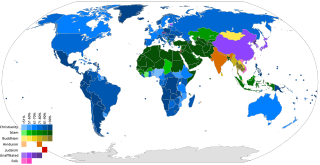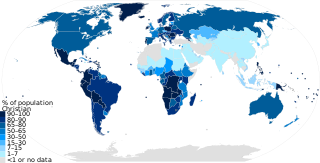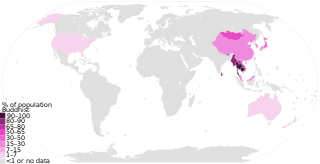Top Qs
Timeline
Chat
Perspective
List of religious populations
From Wikipedia, the free encyclopedia
Remove ads
This is a list of religious populations by number of adherents and countries.

Remove ads
Current world estimates
Pew Research Center made its "Population Growth Projections, 2010–2050"[2] based on 2010 baseline estimates. New estimates for 2020 are still work in progress.[3] Their methodology is published as an appendix.[4]
Notes
Largest religion by country

By proportion
Summarize
Perspective
Christians
Countries and territories with the greatest proportion of Christians from Christianity by country, in 2010:

 Vatican City 100% (100% Roman Catholic)
Vatican City 100% (100% Roman Catholic) Pitcairn Islands 100% (100% Seventh-day Adventist)[6]
Pitcairn Islands 100% (100% Seventh-day Adventist)[6] East Timor 99.6%[7] (mostly Roman Catholic)
East Timor 99.6%[7] (mostly Roman Catholic) Samoa ~99.0% (mostly Protestant)[8]
Samoa ~99.0% (mostly Protestant)[8] Armenia 98.5% (96% Oriental Orthodox)
Armenia 98.5% (96% Oriental Orthodox) American Samoa 98.3% (mostly Protestant; ARDA claim)[9][better source needed]
American Samoa 98.3% (mostly Protestant; ARDA claim)[9][better source needed] Malta 98.1%[10] (mostly Roman Catholic)
Malta 98.1%[10] (mostly Roman Catholic) Venezuela 98.0%[11] (71% Roman Catholic)
Venezuela 98.0%[11] (71% Roman Catholic) Greece 98.0%[12] (95% Eastern Orthodox)
Greece 98.0%[12] (95% Eastern Orthodox) Marshall Islands 97.2% (mostly Protestant)[13]
Marshall Islands 97.2% (mostly Protestant)[13] Tonga 97.2% (mostly Protestant)[14]
Tonga 97.2% (mostly Protestant)[14] San Marino 97.0%[15] (~97% Roman Catholic)
San Marino 97.0%[15] (~97% Roman Catholic) Paraguay 96.9%[16] (mostly Roman Catholic)
Paraguay 96.9%[16] (mostly Roman Catholic) El Salvador 96.4% (mostly Roman Catholic; ARDA claim)[17][better source needed]
El Salvador 96.4% (mostly Roman Catholic; ARDA claim)[17][better source needed] Kiribati 96.0% (mostly Protestant)[18]
Kiribati 96.0% (mostly Protestant)[18] Federated States of Micronesia ~96.0% (mostly Protestant)[19]
Federated States of Micronesia ~96.0% (mostly Protestant)[19] Barbados 95.1% (mostly Protestant)[20]
Barbados 95.1% (mostly Protestant)[20] Papua New Guinea 94.8% (mostly Protestant; ARDA claim)[21][better source needed]
Papua New Guinea 94.8% (mostly Protestant; ARDA claim)[21][better source needed] Mexico 94.6% (mostly Roman Catholic)
Mexico 94.6% (mostly Roman Catholic) Peru 94.5%[22] (mostly Roman Catholic)
Peru 94.5%[22] (mostly Roman Catholic) Romania 93.0% (mostly Eastern Orthodox)[23]
Romania 93.0% (mostly Eastern Orthodox)[23] Poland 92.9% (mostly Roman Catholic)[24]
Poland 92.9% (mostly Roman Catholic)[24] Croatia 91.1% (mostly Roman Catholic)[25]
Croatia 91.1% (mostly Roman Catholic)[25] Philippines 90.0% (mostly Roman Catholic)
Philippines 90.0% (mostly Roman Catholic)
Muslims
Countries and territories with a considerable proportion of Muslims from Islam by country in 2010, excluding foreign workers in brackets:[26]

 Maldives 100%[27]
Maldives 100%[27] Mauritania 99.9%[28]
Mauritania 99.9%[28] Gaza Strip 99.9%[citation needed]
Gaza Strip 99.9%[citation needed] Morocco 99.9%[29]
Morocco 99.9%[29] Yemen 99.8% (65% Sunni, 35% Shia)[26]
Yemen 99.8% (65% Sunni, 35% Shia)[26] Somalia 99.7%[30]
Somalia 99.7%[30] Afghanistan 99.7%[31] (90% Sunni, 10% Shia)[26]
Afghanistan 99.7%[31] (90% Sunni, 10% Shia)[26] Iran 99.6% (95% Shia, 5% Sunni)[32]
Iran 99.6% (95% Shia, 5% Sunni)[32] Tunisia 99.5%
Tunisia 99.5% Azerbaijan 99.2% (55% Shia, 45% Sunni)[26]
Azerbaijan 99.2% (55% Shia, 45% Sunni)[26] Iraq 99.0% (60% Shia, 40% Sunni)[26]
Iraq 99.0% (60% Shia, 40% Sunni)[26] Niger 99.0% (mostly Sunni)[26]
Niger 99.0% (mostly Sunni)[26] Turkey 98.6% (85% Sunni, 15% Shia)[33]
Turkey 98.6% (85% Sunni, 15% Shia)[33] Comoros 98.3%[34]
Comoros 98.3%[34] Algeria 98.0%
Algeria 98.0% Tajikistan 97.9%[35]
Tajikistan 97.9%[35] Saudi Arabia 97.2% (90% Sunni, 10% Shia)[26]
Saudi Arabia 97.2% (90% Sunni, 10% Shia)[26] Sudan 97.0%[36]
Sudan 97.0%[36] Djibouti 96.9%[26]
Djibouti 96.9%[26] Libya 96.6%[37]
Libya 96.6%[37] Pakistan 96.4% (85% Sunni, 12% Shia, 3% Other)[38]
Pakistan 96.4% (85% Sunni, 12% Shia, 3% Other)[38] Uzbekistan 96.3%[26]
Uzbekistan 96.3%[26] Egypt 94.6%[26]
Egypt 94.6%[26] Syria 92.2% (80% Sunni, 20% Shia)[26]
Syria 92.2% (80% Sunni, 20% Shia)[26]
Irreligious and atheists
Countries with the greatest proportion of people without religion, including agnostics and atheists, from Irreligion by country in 2020:[39]

 Czech Republic 78.4%
Czech Republic 78.4% North Korea 71.3%
North Korea 71.3% Estonia 60.2%
Estonia 60.2% Japan 60.0%
Japan 60.0% Hong Kong 54.7%
Hong Kong 54.7% China 51.8%
China 51.8% South Korea 46.6%
South Korea 46.6% Latvia 45.3%
Latvia 45.3% Netherlands 44.3%
Netherlands 44.3% Uruguay 41.5%
Uruguay 41.5% New Zealand 39.6%
New Zealand 39.6% Mongolia 36.5%
Mongolia 36.5% France 31.9%
France 31.9% United Kingdom 31.2%
United Kingdom 31.2% Belgium 31.0%
Belgium 31.0% Vietnam 29.9%
Vietnam 29.9% Sweden 29.0%
Sweden 29.0% Australia 28.6%
Australia 28.6% Belarus 28.6%
Belarus 28.6% United States 28.0%[41]
United States 28.0%[41] Luxembourg 26.7%
Luxembourg 26.7% Germany 26.3%
Germany 26.3% Canada 24.5%
Canada 24.5% Cuba 23.2%
Cuba 23.2% Switzerland 22.8%
Switzerland 22.8% Spain 21.0%
Spain 21.0% Finland 20.8%
Finland 20.8% Hungary 20.3%
Hungary 20.3% Bermuda 19.4%
Bermuda 19.4% Slovenia 18.8%
Slovenia 18.8%
Data is ranked by mean estimate in parentheses. Irreligious includes agnostic, atheist, secular people, and those having no formal religious adherence. It does not necessarily mean that those of this group don't belong to any religion. Some religions have harmonized with local cultures and can be seen as a cultural background rather than a formal religion. The practice of officially associating a family or household with a religion, while not formally practicing the affiliated religion, is common in many countries. Thus, over half of this group is theistic and/or influenced by religious principles, but nonreligious/non-practicing and not true atheists or agnostics. See Spiritual but not religious.
Hindus
Countries with the greatest proportion of Hindus from Hinduism by country in 2010:

 Nepal 81.3%[42]
Nepal 81.3%[42] India 79.8%[43]
India 79.8%[43] Mauritius 48.54%[44]
Mauritius 48.54%[44] Fiji 27.9%[45]
Fiji 27.9%[45] Bhutan 25.0%[46]
Bhutan 25.0%[46] Guyana 24.8%[47]
Guyana 24.8%[47] Suriname 22.3%[48]
Suriname 22.3%[48] Trinidad and Tobago 18.2%[49]
Trinidad and Tobago 18.2%[49] United Arab Emirates 15.0%[50]
United Arab Emirates 15.0%[50] Sri Lanka 12.6%[51]
Sri Lanka 12.6%[51] Kuwait 12.0%[52]
Kuwait 12.0%[52] Bangladesh 9.6%[53]
Bangladesh 9.6%[53] Bahrain 8.1%[54]
Bahrain 8.1%[54] Réunion 6.7%[55]
Réunion 6.7%[55] Malaysia 6.3%[56]
Malaysia 6.3%[56] Singapore 5.1%
Singapore 5.1% Oman 3.0%
Oman 3.0% New Zealand 2.6%[57]
New Zealand 2.6%[57] Pakistan 2.2%[58]
Pakistan 2.2%[58] Seychelles 2.1%[59]
Seychelles 2.1%[59] Indonesia 1.7%[60]
Indonesia 1.7%[60] United Kingdom 1.7%[61]
United Kingdom 1.7%[61] Canada 1.5%[62]
Canada 1.5%[62] South Africa 1.1%[citation needed]
South Africa 1.1%[citation needed] United States 0.7%[63]
United States 0.7%[63]
Buddhists
Countries with the greatest proportion of Buddhists from Buddhism by country in 2010:[64]

Chinese traditional religionists
As a spiritual practice, Taoism has made fewer inroads in the West than Buddhism and Hinduism. Despite the popularity of its great classics the I Ching and the Tao Te Ching, the practice of Taoism has not been promulgated in America with much success.[68] These religions are not ubiquitous worldwide in the way that adherents of bigger world religions are, and they remain primarily an ethnic religion. Nonetheless, Taoist ideas and symbols such as taijitu have become popular throughout the world through tai chi, qigong, and various martial arts.[69]
 Taiwan 33.0–80.0%[70]
Taiwan 33.0–80.0%[70] China 30.0%[71]
China 30.0%[71] Hong Kong 28.0%[72]
Hong Kong 28.0%[72] Macau 13.9%[73]
Macau 13.9%[73] Singapore 8.5%[74]
Singapore 8.5%[74] Malaysia 2.6%[75]
Malaysia 2.6%[75] South Korea 0.2–1.0%[76]
South Korea 0.2–1.0%[76] Philippines 0.01–0.05%
Philippines 0.01–0.05% Indonesia 0.05%
Indonesia 0.05%
In 1999, the Chinese traditional religion had 184,000 believers in Latin America, 250,000 believers in Europe, and 839,000 believers in North America.[77][78]
Ethnic and indigenous religionists
Indigenous statistics come from the 2009 U.S. Department of State's International Religious Freedom Act,[79] based on the highest estimate of people identified as indigenous or followers of indigenous religions that have been well-defined. Due to the syncretic nature of these religions, the numbers may not reflect the actual number of practitioners.
 Togo 35.6%[80]
Togo 35.6%[80] South Sudan 32.9%[81]
South Sudan 32.9%[81] Guinea-Bissau 30.9%[82]
Guinea-Bissau 30.9%[82] North Korea 29.5%[83]
North Korea 29.5%[83] Côte d'Ivoire 25.0%
Côte d'Ivoire 25.0% Sudan 25.0%[84]
Sudan 25.0%[84] Burundi 20.0%
Burundi 20.0% Benin 17.9%[85][better source needed]
Benin 17.9%[85][better source needed] Burkina Faso 15.0%
Burkina Faso 15.0% South Africa 15.0%[86]
South Africa 15.0%[86] Democratic Republic of the Congo 12.0%
Democratic Republic of the Congo 12.0% Central African Republic 10.0%
Central African Republic 10.0% Gabon 10.0%
Gabon 10.0% Lesotho 10.0%
Lesotho 10.0% Nigeria 10.0%
Nigeria 10.0% Sierra Leone 10.0%[87]
Sierra Leone 10.0%[87] Kenya 9.0%
Kenya 9.0% Palau 9.0%[88]
Palau 9.0%[88] Ghana 8.5%
Ghana 8.5% Guinea 5.0%
Guinea 5.0%
Sikhs
Countries with the greatest proportion of Sikhs:

 Canada 2.12%[89][90]
Canada 2.12%[89][90] India 1.72%[95]
India 1.72%[95] Cyprus 1.10%[96]
Cyprus 1.10%[96] United Kingdom 0.88%[97]
United Kingdom 0.88%[97] New Zealand 0.88%[98]
New Zealand 0.88%[98] Australia 0.83%[99][100]
Australia 0.83%[99][100] Oman 0.75%[101]
Oman 0.75%[101] UAE 0.56%[102]
UAE 0.56%[102] Italy 0.37%[116]
Italy 0.37%[116] Singapore 0.35%[117]
Singapore 0.35%[117]
The Sikh homeland is the Punjab state, in India, where Sikhs make up approximately 58% of the population. This is the only place where Sikhs are in the majority. Sikhs have emigrated to countries all over the world – especially to English-speaking and East Asian nations. In doing so they have retained, to an unusually high degree, their distinctive cultural and religious identity.[118]
Sikhs are not ubiquitous worldwide in the way that adherents of larger world religions are, and they remain primarily an ethnic religion. They can be found in many international cities and have become an especially strong religious presence in the United Kingdom and Canada.[119] Sikhism is the fastest growing religion in New Zealand and Australia.[120][121]
Spiritists
 Cuba 10.3%
Cuba 10.3% Jamaica 10.2%
Jamaica 10.2% Brazil 4.8%
Brazil 4.8% Suriname 3.6%
Suriname 3.6% Haiti 2.7%
Haiti 2.7% Dominican Republic 2.2%
Dominican Republic 2.2% The Bahamas 1.9%
The Bahamas 1.9% Nicaragua 1.5%
Nicaragua 1.5% Trinidad and Tobago 1.4%
Trinidad and Tobago 1.4% Guyana 1.3%
Guyana 1.3% Venezuela 1.1%
Venezuela 1.1% Colombia 1.0%
Colombia 1.0% Belize 1.0%
Belize 1.0% Honduras 0.9%
Honduras 0.9% Puerto Rico 0.7%
Puerto Rico 0.7% Panama 0.5%
Panama 0.5% Iceland 0.5%
Iceland 0.5% Guadeloupe 0.4%
Guadeloupe 0.4% Argentina 0.2%
Argentina 0.2% Guatemala 0.2% (ARDA claim)[122][better source needed]
Guatemala 0.2% (ARDA claim)[122][better source needed]
Spiritist estimates come from a single source, which gives a relative indication of the size of the Spiritist communities within each country.
Jews
Countries with the greatest proportion of Jews in 2017:[123]

 Israel 73.60%
Israel 73.60% Gibraltar 2.00%
Gibraltar 2.00% United States 1.76%
United States 1.76% Canada 1.07%
Canada 1.07% France 0.70%
France 0.70% Hungary 0.485%
Hungary 0.485% Uruguay 0.483%
Uruguay 0.483% Australia 0.47%
Australia 0.47% United Kingdom 0.44%
United Kingdom 0.44% Argentina 0.41%
Argentina 0.41% U.S. Virgin Islands 0.36%
U.S. Virgin Islands 0.36% Belgium 0.259%
Belgium 0.259% Panama 0.25%
Panama 0.25% Latvia 0.24%
Latvia 0.24% Switzerland 0.22%
Switzerland 0.22% Netherlands 0.17%
Netherlands 0.17% Estonia 0.154%
Estonia 0.154% Bermuda 0.154%
Bermuda 0.154% Sweden 0.152%
Sweden 0.152% Germany 0.14%
Germany 0.14% South Africa 0.124%
South Africa 0.124% Ukraine 0.124%
Ukraine 0.124% Russia 0.122%
Russia 0.122% Denmark 0.112%
Denmark 0.112% New Zealand 0.11%[57]
New Zealand 0.11%[57]
Remove ads
By population
Summarize
Perspective
Christians
Largest Christian populations in 2011:
 United States 229,157,250[124] (details)
United States 229,157,250[124] (details) Brazil 169,213,130[125]
Brazil 169,213,130[125] Russia 114,198,444[126]
Russia 114,198,444[126] Mexico 106,204,560[127]
Mexico 106,204,560[127] Nigeria 80,510,000[128]
Nigeria 80,510,000[128] Philippines 78,790,000[129]
Philippines 78,790,000[129] China 67,070,000[128]
China 67,070,000[128] Democratic Republic of the Congo 63,150,000[128]
Democratic Republic of the Congo 63,150,000[128] Italy 55,832,000
Italy 55,832,000 Ethiopia 51,477,950
Ethiopia 51,477,950 Germany 50,752,580[130]
Germany 50,752,580[130] Colombia 44,502,000
Colombia 44,502,000 Ukraine 41,973,000
Ukraine 41,973,000 South Africa 40,243,000
South Africa 40,243,000 France 39,560,000[128]
France 39,560,000[128] Spain 38,568,000
Spain 38,568,000 Poland 36,526,000
Poland 36,526,000 Kenya 33,625,790
Kenya 33,625,790 Argentina 33,497,100
Argentina 33,497,100 United Kingdom 33,200,417
United Kingdom 33,200,417 Uganda 29,943,000
Uganda 29,943,000 Indonesia 29,579,316[131]
Indonesia 29,579,316[131] India 28,436,000
India 28,436,000 Venezuela 28,340,790
Venezuela 28,340,790 Peru 27,365,100
Peru 27,365,100
Muslims
Largest Muslim populations in 2017:
 Indonesia 229,000,000[citation needed] (details)
Indonesia 229,000,000[citation needed] (details) Pakistan 215,000,000[132]
Pakistan 215,000,000[132] India 209,000,000[133]
India 209,000,000[133] Bangladesh 153,000,000[citation needed]
Bangladesh 153,000,000[citation needed] Nigeria 117,000,000[134]
Nigeria 117,000,000[134] Egypt 87,500,000[citation needed]
Egypt 87,500,000[citation needed] Iran 82,000,000[135]
Iran 82,000,000[135] Turkey 79,850,000[citation needed]
Turkey 79,850,000[citation needed] Ethiopia 48,000,000[136]
Ethiopia 48,000,000[136] Sudan 44,000,000[citation needed]
Sudan 44,000,000[citation needed] Iraq 41,000,000[137]
Iraq 41,000,000[137] Algeria 39,000,000[138]
Algeria 39,000,000[138] Morocco 38,000,000[29]
Morocco 38,000,000[29] Afghanistan 37,000,000[139]
Afghanistan 37,000,000[139] Saudi Arabia 33,000,000[citation needed]
Saudi Arabia 33,000,000[citation needed] Uzbekistan 33,648,090[140]
Uzbekistan 33,648,090[140] Yemen 30,000,000[141]
Yemen 30,000,000[141] China 28,000,000[citation needed]
China 28,000,000[citation needed] Russia 25,000,000[142]
Russia 25,000,000[142] Tanzania 22,000,000[citation needed]
Tanzania 22,000,000[citation needed] Niger 22,000,000[citation needed]
Niger 22,000,000[citation needed]
Hindus
Largest Hindu populations in 2020:[143]
 India 1,120,000,000
India 1,120,000,000 Nepal 28,600,000
Nepal 28,600,000 Bangladesh 14,274,430
Bangladesh 14,274,430 Indonesia 4,640,000
Indonesia 4,640,000 Pakistan 4,400,000
Pakistan 4,400,000 Sri Lanka 3,090,000
Sri Lanka 3,090,000 United States 2,510,000
United States 2,510,000 Malaysia 1,940,000
Malaysia 1,940,000 United Arab Emirates 1,239,610
United Arab Emirates 1,239,610 United Kingdom 1,030,000
United Kingdom 1,030,000 Myanmar 890,000[144]
Myanmar 890,000[144] South Africa 682,302
South Africa 682,302 Mauritius 665,820
Mauritius 665,820 Canada 610,000
Canada 610,000 Saudi Arabia 440,000
Saudi Arabia 440,000 Australia 410,000
Australia 410,000 Tanzania 403,570
Tanzania 403,570 Singapore 380,000
Singapore 380,000 Qatar 360,000
Qatar 360,000 Kuwait 330,000
Kuwait 330,000 Trinidad and Tobago 310,000[49]
Trinidad and Tobago 310,000[49] Fiji 270,000[citation needed]
Fiji 270,000[citation needed] Guyana 200,000[145]
Guyana 200,000[145] Yemen 200,000[146]
Yemen 200,000[146] Bhutan 190,000
Bhutan 190,000 Suriname 120,785[147]
Suriname 120,785[147] Germany 120,000
Germany 120,000
Buddhists
Largest Buddhist populations in 2020.[148]
 Thailand 67,620,000
Thailand 67,620,000 China 53,380,000
China 53,380,000 Myanmar 47,210,000
Myanmar 47,210,000 Japan 46,990,000
Japan 46,990,000 Vietnam 22,580,000
Vietnam 22,580,000 Cambodia 16,240,000
Cambodia 16,240,000 Sri Lanka 15,700,000
Sri Lanka 15,700,000 South Korea 9,850,000
South Korea 9,850,000 India 9,550,000
India 9,550,000 Malaysia 6,400,000
Malaysia 6,400,000 United States 3,800,023
United States 3,800,023 Indonesia 2,062,000
Indonesia 2,062,000 Bangladesh 1,001,974
Bangladesh 1,001,974
Sikhs
Largest Sikh population in 2023
 India 23,786,000[149][a][150][151]
India 23,786,000[149][a][150][151] Canada 771,790[152][153]
Canada 771,790[152][153] United Kingdom 524,000[154]
United Kingdom 524,000[154] United States ~280,000[175]
United States ~280,000[175] Australia 210,400[176][177]
Australia 210,400[176][177] Italy 210,000[186]
Italy 210,000[186] Malaysia 100,000[187][188][189]
Malaysia 100,000[187][188][189] Thailand 70,000[190]
Thailand 70,000[190] United Arab Emirates 52,000[102]
United Arab Emirates 52,000[102] Philippines 50,000[191][192]
Philippines 50,000[191][192] New Zealand 40,908[193]
New Zealand 40,908[193] Oman 35,540[194]
Oman 35,540[194] Portugal 35,000[195]
Portugal 35,000[195] France 30,000[196]
France 30,000[196] Spain 26,000[197]
Spain 26,000[197] Germany 25,000[198]
Germany 25,000[198] Bangladesh 23,000[199]
Bangladesh 23,000[199] Greece 20,000[200]
Greece 20,000[200] Kuwait 15,000[201][202]
Kuwait 15,000[201][202] Hong Kong 15,000[203]
Hong Kong 15,000[203] Netherlands 15,000[204]
Netherlands 15,000[204]
Jews
Largest Jewish populations in 2017:[123]
 Israel 6,451,000
Israel 6,451,000 United States 5,700,000
United States 5,700,000 France 456,000
France 456,000 Canada 390,000
Canada 390,000 United Kingdom 289,500
United Kingdom 289,500 Argentina 180,500
Argentina 180,500 Russia 176,000
Russia 176,000 Germany 116,500
Germany 116,500 Australia 113,200
Australia 113,200 Brazil 93,800
Brazil 93,800 South Africa 69,300
South Africa 69,300 Ukraine 53,000
Ukraine 53,000 Hungary 47,500
Hungary 47,500 Mexico 40,000
Mexico 40,000 Netherlands 29,800
Netherlands 29,800 Belgium 29,300
Belgium 29,300 Italy 27,300
Italy 27,300 Switzerland 18,700
Switzerland 18,700 Chile 18,300
Chile 18,300 Uruguay 16,900
Uruguay 16,900 Turkey 15,300
Turkey 15,300 Sweden 15,000
Sweden 15,000 Spain 11,800
Spain 11,800 Belarus 10,000
Belarus 10,000 Panama 10,000
Panama 10,000
Baháʼís
Largest Baháʼí populations in 2010 in countries with a national population ≥200,000:[205][better source needed]
 India 1,897,651
India 1,897,651 United States 512,864
United States 512,864 Kenya 422,782
Kenya 422,782 Vietnam 388,802
Vietnam 388,802 Bangladesh 300,000[206]
Bangladesh 300,000[206] Congo, Democratic Republic of the 282,916
Congo, Democratic Republic of the 282,916 Philippines 275,069
Philippines 275,069 Iran 251,127
Iran 251,127 Zambia 241,112
Zambia 241,112 South Africa 238,532
South Africa 238,532 Bolivia 215,359
Bolivia 215,359 Tanzania 190,419
Tanzania 190,419 Venezuela 169,811
Venezuela 169,811 Uganda 95,098
Uganda 95,098 Chad 94,499
Chad 94,499 Pakistan 87,259
Pakistan 87,259 Myanmar 78,915
Myanmar 78,915 Colombia 70,504
Colombia 70,504 Malaysia 67,549
Malaysia 67,549 Thailand 65,096
Thailand 65,096 Papua New Guinea 59,898
Papua New Guinea 59,898
Jains
In 2005, per ARDA:[207][better source needed]
 India 5,146,697
India 5,146,697 United States 79,459
United States 79,459 Kenya 68,848
Kenya 68,848 United Kingdom 35,000
United Kingdom 35,000 Canada 12,101
Canada 12,101 Tanzania 9,002
Tanzania 9,002 Nepal 6,800
Nepal 6,800 Uganda 2,663
Uganda 2,663 Myanmar 2,398
Myanmar 2,398 Malaysia 2,052
Malaysia 2,052 South Africa 1,918
South Africa 1,918 Fiji 1,573
Fiji 1,573 Japan 1,535
Japan 1,535 Belgium 1,500
Belgium 1,500 Australia 1,449
Australia 1,449 Suriname 1,217
Suriname 1,217 Ireland 1,000
Ireland 1,000 Bangladesh 1,000
Bangladesh 1,000 Réunion 981
Réunion 981 Hong Kong 500 families[208]
Hong Kong 500 families[208] Yemen 229
Yemen 229
Remove ads
See also
Religions:
Remove ads
Notes
References
External links
Wikiwand - on
Seamless Wikipedia browsing. On steroids.
Remove ads
